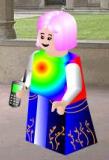Chapter Outline - Study Guide p.11
Important paragraph that sets the tone that course is not simply about Renaissance artists recovering the excellence of the antique (i.e. Greek and Roman 5th CBE - 2nd CE) nor is it about the notion that the development of naturalistic art simply copied the antique.
Course Book 1 - Making Renaissance Art
1) Vasari and the Italian Renaissance
Vasari wrote Lives of Artists which has dictated the way we view the Renaissance and Florence. Although his claims will be considered, his writings will not set the agenda for the course. Not just Florence but other Italian and European art and artists are discussed.
2) The Revival of the Antique
From the universities that were developing in the new urban centres in Italy there came the humanists, followers of the teachings and thinking of Petrarch, based on ancient manuscripts. Many humanists became holders of influential positions and tutors to the children of the aristocracy, thus spreading Petrarch's ideas.
Drawing on works such as Donatello's David, Van Eyck's Virgin and Child at the Fountain, and Nanni di Banco's Four Crowned Saints, the point is made that their work was not just a copying of the ancient art of Greece and Rome, but that they did incorporate some of its naturalistic styles into the work. Also ancient references could add cachet to their work i.e. Greek and Latin inscriptions.
3) Imitating Nature
Works of art were not exclusively life-like, artists continued to produce work in the Greek style as can be seen in Van Eyck's Virgin and Child at the Fountain.
Conclusion
Sums up introduction by observing that there are many approaches to the 'making' of art that will be covered in this book.
Introduction of Art in Renaissance Italy written by Evelyn Welch.
Renaissance was a description meaning 're-birth' introduced by Jacob Burckhart (1818 - 97) (a northern European historian) which was used to describe what he saw as a 15/16th century episode which formed the crucial moment when ideals such as 'individualism, nationalism, secularism and capitalist entrepreneuralism were born and then transmitted to the rest of the western world' (Welch p.9). This idea tends to focus on the progression of artistic styles particularly within Tuscany. Vasari's work Lives of the Artists certainly contributes to this notion, but it 'transforms the earlier centuries in Italian art into ante-rooms for the 16th Century' (Welch p.11).
In the 1970's British art historian Michael Baxandall 'popularised the concept of the 'period eye' the immediate social and visual context in which pictures were both created and observed'. (Welch p.22)
This introduction reviews the history of the Italian peninsular and its various city states particularly, and also the wider influence that came to bear upon them from other parts of Europe and from the Ottoman rule in Constantinople. It identifies not just the differences and divisions, but also the unifying features that ran across the peninsular e.g. religious belief, moral and patrician traditions. It also covers the development and networking of academics, particularly humanists following the writings of Petrarch. All of this is presented so as to enable the reader to take a more informed view and to be better able to use the 'period eye' when looking at and considering the art of the period and particularly the Renaissance. It suggests that the explanations for Renaissance art are far more diverse than the rather neat and simplistic views that have been traditionally put forward.
The Northern Renaissance - Jeffrey Chips Smith
Introduction.
This introduction sets the scene in historical terms and begins to examine what the term ‘Renaissance’ might signify in northern Europe.
Wednesday, 16 January 2008
Subscribe to:
Post Comments (Atom)

No comments:
Post a Comment